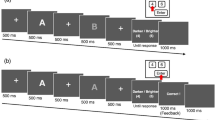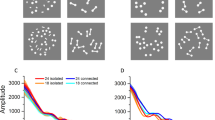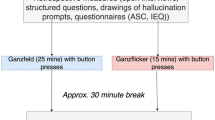Abstract
WE reported earlier1,2 a method which permits reproducible electrical stimulation of phosphenes—that is subjective light patterns, visible with closed eyes—without surgery. It was shown that these patterns resembled line drawings of ‘geometrical’ forms, and that a great number of them could be stimulated within a rather small bandwidth (±10 per cent of the mean excitation frequency) within the electro-encephalographic frequency range. In the meantime, the dependence of this effect on the shape of the stimulating current3, the identification and lifetime of single phosphenes4 and the influence of hallucinogenic drugs on their shape5 have also been investigated. In addition, copies of 520 phosphenes observed by 313 subjects have been collected3: it was possible to classify these into 15 form groups (‘phosphene-Linnaeus’, 1–15, first two columns of Table 1).
This is a preview of subscription content, access via your institution
Access options
Subscribe to this journal
Receive 51 print issues and online access
$199.00 per year
only $3.90 per issue
Buy this article
- Purchase on Springer Link
- Instant access to full article PDF
Prices may be subject to local taxes which are calculated during checkout
Similar content being viewed by others
References
Knoll, M., Schweiz. Z. Psychol., 17, 110 (1958).
Knoll, M., and Kugler, J., Nature, 184, 1823 (1959).
Höfer, O., Elektromedizin, 8, 72 (1963).
Knoll, M., Höfer, O., Lawder, S. D., and Lawder, U. M., Elektromedizin., 7, 235 (1962).
Knoll, M., Kugler, J., Höfer, O., and Lawder, S. D., Confinia Neurol., 23, 201 (1963).
Knoll, M., and Knoll-Greiling, U., in Buddhism and Culture, edit. by Yamaguchi, P., 201 and 213 (Kyoto, 1960).
Kellogg, R., What Children Scribble and Why (San Francisco, 1955).
Knoll, M., and Kugler, J., I.C.M.C.I.—Lecture, Tokyo, Sept. 10(1964).
Author information
Authors and Affiliations
Rights and permissions
About this article
Cite this article
KELLOGG, R., KNOLL, M. & KUGLER, J. Form-similarity between Phosphenes of Adults and pre-School Children's Scribblings. Nature 208, 1129–1130 (1965). https://doi.org/10.1038/2081129a0
Issue Date:
DOI: https://doi.org/10.1038/2081129a0
Comments
By submitting a comment you agree to abide by our Terms and Community Guidelines. If you find something abusive or that does not comply with our terms or guidelines please flag it as inappropriate.



